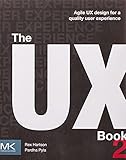The UX book : Agile UX design for a quality user experience / Rex Hartson, Pardha Pyla.
Material type: TextPublication details: Amsterdam : Morgan Kaufmann, 2019Edition: 2nd edDescription: xxvi, 888 p. : ill. (col.) ; 24 cmISBN: 9780128053423 (pbk.); 0128053429 (pbk.)Subject(s): User interfaces (Computer systems) -- Design | Human-computer interactionDDC classification: 005.437 LOC classification: QA76.9.U83 | H37 2019
TextPublication details: Amsterdam : Morgan Kaufmann, 2019Edition: 2nd edDescription: xxvi, 888 p. : ill. (col.) ; 24 cmISBN: 9780128053423 (pbk.); 0128053429 (pbk.)Subject(s): User interfaces (Computer systems) -- Design | Human-computer interactionDDC classification: 005.437 LOC classification: QA76.9.U83 | H37 2019| Item type | Current library | Collection | Call number | Copy number | Status | Date due | Barcode |
|---|---|---|---|---|---|---|---|
 Staff Circulation
Staff Circulation
|
APU Library Open Shelf | Book | QA76.9.U83 H37 2019 c.1 (Browse shelf (Opens below)) | 1 | Checked out | 06/01/2025 | 00012392 |
 General Circulation
General Circulation
|
APU Library Open Shelf | Book | QA76.9.U83 H37 2019 c.2 (Browse shelf (Opens below)) | 2 | Available | 00012395 |
Browsing APU Library shelves, Shelving location: Open Shelf, Collection: Book Close shelf browser (Hides shelf browser)

|

|

|

|

|

|

|
||
| QA76.9.U83 H33 1998 c.3 User and task analysis for interface design / | QA76.9.U83 H37 2012 c.1 The UX Book : process and guidelines for ensuring a quality user experience / | QA76.9.U83 H37 2019 c.1 The UX book : | QA76.9.U83 H37 2019 c.2 The UX book : | QA76.9.U83 H59 1993 c.1 Developing user interfaces : | QA76.9.U83 H59 1993 c.2 Developing user interfaces : | QA76.9.U83 H59 1993 c.3 Developing user interfaces : |
Includes bibliographical references and index.
<p>PART 1. INTRODUCTION Chapter 1. What is UX and UX design? Chapter 2. The Wheel: UX processes, lifecycles, methods, and technique Chapter 3. Scope, rigor, complexity, and project perspectives Chapter 4. Agile lifecycle processes and the Funnel Model of Agile UX Chapter 5. Prelude to the process chapters Chapter 6. Background: Introduction</p> <p>PART 2. UNDERSTAND NEEDS Chapter 7. Usage research data elicitation Chapter 8. Usage research data analysis Chapter 9. Usage research data modeling Chapter 10. UX design requirements: User stories and requirements Chapter 11. Background: Understand Needs</p> <p>PART 3. DESIGN SOLUTIONS Chapter 12. The nature of UX design Chapter 13. Bottom-up vs. top-down design Chapter 14. Generative design: Ideation, sketching, and critiquing Chapter 15. Mental models and conceptual design Chapter 16. Designing the ecology and a pervasive information architecture Chapter 17. Designing the interaction Chapter 18. Designing for emotional impact Chapter 19. Background: Design</p> <p>PART 4. PROTOTYPE CANDIDATES Chapter 20. Prototyping</p> <p>PART 5. EVALUATE UX Chapter 21. UX evaluation methods and techniques Chapter 22. UX evaluation: UX goals, metrics, and targets Chapter 23. Preparation for empirical UX evaluation Chapter 24. Empirical data collection methods and techniques Chapter 25. Analytical data collection methods and techniques Chapter 26. UX Evaluation: Data analysis Chapter 27. UX evaluation: Reporting results Chapter 28. Background: UX evaluation</p> <p>PART 6. AGILE UX AND CONNECTIONS TO AGILE SE Chapter 29. Connecting agile UX with agile software development Chapter 30. Background: Agile connections</p> <p>PART 7. AFFORDANCES AND DESIGN GUIDELINES Chapter 31. Affordances in UX design Chapter 32. The interaction cycle Chapter 33. UX design guidelines Chapter 34. Background: Affordances and UX design principles</p>


There are no comments on this title.